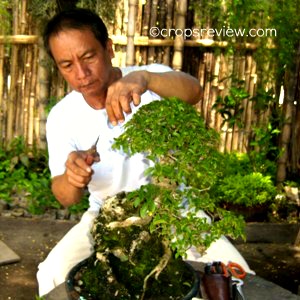Just exactly how to prune is difficult to teach or execute.
Pruning is the removal of unwanted parts of a plant in order to attain a specific purpose or purposes.
But the choice of the parts to be removed is hampered by many factors.
There are simply no standards. It is because each plant has distinct architecture and growth habits and plant responses to pruning are not the same.
The difficulty is further compounded considering that pruners, as humans, deviate in their perception of right and wrong, especially in the selection of branches to be removed or retained.
The specific purpose of pruning will also affect decision-making on how to prune any tree specifically the choice of main branches or any part thereof to be removed and the severity of pruning.
Where crop-livestock integrated farming is intended, the lowermost branches may have to be removed to prevent damage due to nibbling, as in mango.
This is likewise necessary to allow the passage of farm implements and vehicles or to enhance visibility and wind movement on the ground.
For insect pests and disease control, it is easy to identify damaged or diseased parts.
In bonsai, pruning does not only consider the physiological requirements of the tree but also to induces or maintains dwarfing and enhances artistic effects which vary according to bonsai style.

Basic rules in pruning bonsai can be applied to fruit trees
Fortunately, as to subsequent pruning of established fruit trees, we can get useful tips on how to prune properly from bonsai.
At least it did to me. It helped me to understand more why pruning is important in crop care.
Thus in teaching how to prune, I consider bonsai trees as the best specimen to explain the basics.
Small ones are handy and they can be carried anywhere for demo.
The pruning of bonsai trees, particularly those of the single-trunk, formal upright style, is not only intended for aesthetics.
The regular, meticulous pruning of these trees and the other cultural practices including root pruning, watering, fertilizing and crop protection make these trees live long which, as intended, is for eternity.
Some masterpiece bonsai trees have lived for hundreds of years changing hands from generation to generation, even surpassing the life span of the same trees in the wild.
The Rules in Bonsai
Here are some tips from the rules in bonsai that will shed more light on how to prune fruit trees:
1. Triangular and wheel-spoke arrangement of main branches.
In bonsai, the first three main branches (left-back-right or right-back-left), viewed from the top and imagining that they are the only existing branches, form a triangle of unequal sides (scalene) when these branches at points of equal distances from the trunk are connected with straight lines.

This arrangement is followed for every three branches going upward but the branches ought to emerge from different sides of the tree, meaning that no branches from lower to upper portions of the trunk should be found along the same vertical axis.
Viewed from the top, all the branch axes will have radiated from a common point (the trunk) without crisscrossing each other, like the spokes of a cartwheel but not those of the common bicycle in which the spokes show an X pattern.
2. Spiral arrangement of main branches
The bases of the main branches progress upward in a spiral pattern, similar to the spring of a notebook or a circular stair, but with lengths that progressively become shorter upward.
This means that the branches emerge from different sides of the trunk and are separated by vertical distance like the steps in a circular stair.
In relation to plant physiology, these rules ensure that the branches are not clustered at any part of the trunk both vertically and horizontally.
Along with the shorter branches at the upper portion of the canopy, these minimize shading of the lower leaves and promote maximum absorption of sunlight by the whole plant.
Sunlight is needed in photosynthesis and its penetration into the canopy allows the inner and the bottom leaves to participate in the photosynthetic production of food for the whole plant as well as discourages certain insect pests.
Wind movement is also enhanced which will promote gas exchange and correct excessive humidity which can favor the reproduction of disease pathogens as in durian.
Moreover, the removal of unnecessary branches in fruit trees will likely lead to the rapid growth of the retained branches due to the elimination of non-photosynthesizing leaves and reduced competition for the usage of net photosynthate.
On the contrary, it does not necessarily mean that the above bonsai rules should be strictly adopted.
Even in bonsai trees, there are gaps because every tree cannot just be told to produce branches as the bonsaist wills.
Also, bonsai is primarily a visual art and only secondarily a horticultural science.
In particular, the three-branches rule is mainly for aesthetics and for judging bonsai.
Nevertheless, these rules offer useful tips that can be used in learning how to prune.
It can be concluded that to enhance the growth and development of fruit trees the branches must be well distributed around and throughout the length of the trunk for the main purpose of enhancing maximum penetration of sunlight and wind movement.
Further, the learning process on how to prune can be reinforced by visual inspection of trees with compact canopies. It will show that trees undergo natural pruning.
Small branches in the interior of the canopy just naturally die.
This should not be interpreted as an indication that pruning is not necessary because trees anyway do it naturally.
Rather, it is a sign that plant vigor, canopy expansion, and crop yield can be improved significantly by the timely removal of unwanted parts.
However, there are no hard rules on the proper branch-to-branch vertical distance.
